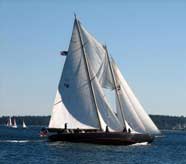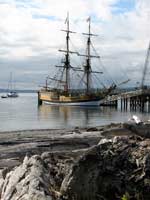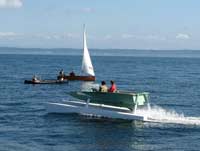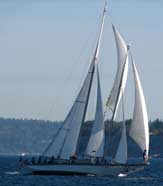| The Kokopelli cruises of recent years have become
frustrating, as light winds and dropping lake levels
make it increasingly difficult for our diverse group
to actually sail anywhere. Most of the beaches where
we used to camp are now perched atop 100 foot high
sandstone cliffs, well out of reach. And the light
air sailing is annoying, since the power boat wakes
roll you hard enough to spill any wind from your sails.
The vertical rock canyon walls don't stop these waves
either, but merely rebound them back into the channel.
Traveling up the busier side canyons is akin to boating
in a washing machine.
|
|

|
Added to these difficulties were the rains of 2006,
with over 3" during the week. For once, Thayer
wasn't bragging about never needing a tent at Powell!
Somewhere during a long, wet night, as I perched upon
my duffel of bedding, and felt the water wash past
my ankles (did I mention I was inside my tent?), I
decided there had to be a better way to go cruising.
A discussion with the soggy crew the next morning
came up with the radical notion of going to the Pacific
Northwest, to avoid the rains in the desert! Or maybe
the thinking was, if we're going to get wet, we might
as well go see someplace new.
So this year, the intrepid Kokonauts traveled to
the Wooden Boat Show ,in Port Townsend, Washington.
Several of our members have been visiting the area
for years, and Dwight and Joan Nicholson even bought
some land there, and were in the process of building
their retirement home. Dwight let us camp on his lot
(complete with Porta potti!), so with a free camp
site only a mile from the show, it was a winning situation.
Port Townsend is situated on the northeastern corner
of the Olympic peninsula, and was the worlds leading
exporter of douglas fir for decades. Lumbering, combined
with the ferry terminal and rich salmon fishery, led
to a prosperous community, with many nice old homes.
When the extractive industries faltered in the sixties,
and home prices plummeted, Townsend became an attractive
destination for counter culture types who were tired
of life in the big cities.
The dream was to buy an old place, and work a variety
of jobs, while you lived cheaply, and built a boat.
Eventually, you would sail off over the horizon, and
see the world. Some of the Port Townsend crowd did
just that, but found they had left a prettier spot,
with a better lifestyle, than anything they could
find in their travels. So eventually, many of these
sailors returned, and found work in the local marine
businesses, using the skills they had learned while
home building their boats.
The area is now under siege by baby boom retirees,
who wish to escape Seattle (3 hours away), enjoy the
relatively dry weather (they're in the rain shadow
of the Olympics). Happily, Townsend has done a good
job with their zoning, and doesn't have the highway
strip mall sprawl that's ruined other scenic spots
(like nearby Squim and Port Angeles). So it is a charming
place to retire to, if you can tolerate the gray weather
and 50 degree water.
The town faces east, and is divided into the touristy
waterfront area "downtown", and a quieter
residential area, on the bluff 200' above. Along the
waterfront, there's a large marina and boat yard complex
(P.T. Boat Haven) south of town, where hundreds of
boats are stored, and many more are under repair on
the hard. On the north end of town, there's a small
artificial harbor, perhaps 200 yards deep, cut right
into the point (Point Hudson Marina). There, a pair
of floating docks is surrounded by marine businesses,
including a couple of small working yards, a sail
loft, a rigging loft, boat building shops, and Pygmy
kayaks. This small harbor, with beach to the north,
and great views of the bay and Cascades, is the perfect
venue for a boat show.
| |

|
The event is well run, and reasonably priced ($24.00
for 3 days), with a busy schedule of events on friday/saturday/sunday.
There are 4 "stages" used for the lectures,
which cover everything from rigging to spar making
to celestial navigation to weather basics to beach
cruising to varnishing techniques to new woods for
boats. There's also a music tent with hourly performances
all day each day, nicely located right next to the
food vendor. And the kids area, with the usual model
builders pounding away, plus stage performances and
nature walks. What's best about the whole thing is
that it's all locals, with home grown talent on display
in every area. The opening music act was a young woman
of about 13, crooning classic torch songs, while her
Dad and his garage band cranked out the rock behind
her. Terrific stuff.
In the water, the boats were rafted up 3 or 4 deep,
with friendly owners aboard to show the vessels and
tell their stories. The variety was exceptional, and
ranged from the 97' 1924 vintage power yacht Olympus,
down to some beautiful small dinghies. There were
over a dozen schooners, many 25' to 45' cruising boats
in both sail and power, and a wonderful array of open
sailing designs. There were also lots of pulling boats,
kayaks, multi-oar boats and shells around. The folks
around Townsend seem to prefer double ended designs,
and I also noticed a lot of functional engine wells
tucked into these otherwise traditional craft. It's
probably the only place I've been where the number
of gaff, gunter and lug rigs outnumbered the marconi
boats.
| |

|
Each day featured on the water events, like friday's
small sailors race (<26'), Saturday's rowing and
schooner races, and Sunday's big sail by, where all
the departing boats just go out and sail around together.
On the periphery of the event were some larger ships,
open for inspection, and available for day sails,
like the square rigged Lady Washington, the big schooner
Adventuress (1913), and the 90' S & S yawl Odyssey
(1938). Most of these big guys have to work for a
living, and are crewed by cheerful youth groups. They
work the shows, take week long elder hostel cruises
of the San Juans, or mainly just day sail tourists
out of the busier ports.
Everyone I met at Port Townsend was pleasant and
knowledgeable, so there was little of the "carny"
atmosphere that often goes with these big events.
Compared to the Wooden Boat show at Mystic, Port Townsend's
is really down to earth, both in price and atmosphere.
Mystic cultivates a museum atmosphere, with reverence
for the traditions, and lots of academic knowledge,
but relatively few sailors involved. Port Townsend
is a working boat maintenance center, with ten times
the building activity of Mystic, and much more approachable
craftsmen.
| |

|
My only complaint with the Townsend show would be
that there's too much to do and see in just 3 days.
Each evening, I would pour over the next day's schedule,
and make the hard decisions about which lectures/performances
to attend the next day. Then in the morning, I would
arrive with my agenda worked out, and proceed to miss
everything I had planned to do, as I got talking to
folks about their boats and travels. With the spectacular
weather, it was hard to drag myself into the lecture
rooms, and I spent many happy hours on the point,
watching the wonderful boats sail by. The big schooner
race finished right off the harbor, and it was thrilling
to watch these big vessels hug the shore as they went
past. There was over 2 knots of current running against
them at the point, so the guys inside often passed
the folks staying out in the deeper water. Where else
can you watch a beetle cat pass a 60' schooner !
IF YOU GO: Port Townsend is 3 hours
from Seattle, whether you take the ferry from Whidbey
island, or drive around through Tacoma. There are
not a lot of motels or public lodging in town, so
many people just come for the day on the ferry. Fridays
are more for locals, while Saturday and Sunday afternoons
are most crowded.
Folks who were there for the weekend seemed to camp.
The park at Fort Worden has 2 camp grounds, with RV
hookups and tent sites ($31/night), and also old officers
quarters available to rent. The Jefferson county fairground
has simpler camp sites, for a more reasonable $ 12/night.
You can also buy a shower there for $ 1.00.
Port Townsend is a very bicycle friendly community,
and everything's within a couple of miles of each
other, so I'd suggest two wheels for getting around
town, to and from the camping areas. If you arrive
by boat, you can anchor right off town, and land a
dink anywhere ashore. You're fine in the prevailing
westerly winds, but if it blows hard from any other
direction, you'll want to move into the big marina,
or to an anchorage across the bay.

|